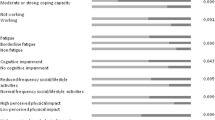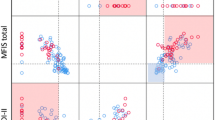Abstract
Depression is a frequent symptom in multiple sclerosis (MS) which has a negative impact on quality of life and cognitive status. The purpose of this study was to determine the prevalence and associated factors of depression, and status of antidepressant use in Iranian MS patients. One-hundred and sixty patients with definite MS were included. Demographic and clinical characteristics were recorded. Fatigue and depression were evaluated using the fatigue severity scale and Beck depression inventory-II. Cognitive performance and disability were examined by mini-mental status examination and expanded disability status scale. Multiple logistic regressions were used to determine the associated factors of depression and antidepressant use. The prevalence of depression and severe depression was 59.4 and 18.1 %, respectively. However, only 21.1 % of patients were on antidepressant treatment, while the prevalence of unrecognized/untreated depression was found to be as high as 44.1 %. Multivariable analysis showed that fatigue (P < 0.0001, OR = 5.98, 95 % CI = 2.9–12.3) and older age (P = 0.027, OR = 2.24, 95 % CI = 1.09–4.6) were associated with depression in MS patient. A significant association was found between fatigue and antidepressant use (P = 0.001, OR = 6.81, 95 % CI = 2.26–20.48). Our findings demonstrate that depression is significantly associated with fatigue and older age, regardless of other factors. Moreover, despite the high prevalence of depression in MS, most patients do not receive adequate treatment.

Similar content being viewed by others
References
Noseworthy J, Lucchinetti C, R M (2000) Multiple sclerosis. N Engl J Med 343(13):938–952
Ramagopalan SV, Sadovnick AD (2011) Epidemiology of multiple sclerosis. Neurol Clin 29:207–217
Sahraian MA, Khorramnia S, Ebrahim MM (2010) Multiple sclerosis in Iran: a demographic study of 8,000 patients and changes over time. Eur Neurol 64(6):331–336
Etemadifar M, Maghzi AH (2011) Sharp increase in the incidence and prevalence of multiple sclerosis in Isfahan. Iran Mult Scler 17(8):1022–1027
Elhami S, Mohammad K, Sahraian M, Eftekhar H (2011) A 20-year incidence trend (1989–2008) and point prevalence (March 20, 2009) of multiple sclerosis in Tehran, Iran: a population-based study. Neuroepidemiology 36(3):141–147
Moghtaderi A, Rakhshanizadeh F, Shahraki-Ibrahimi S (2013) Incidence and prevalence of multiple sclerosis in southeastern Iran. Clin Neurol Neurosurg 115(3):304–308. doi:10.1016/j.clineuro.2012.05.032
Bamer AM, Cetin K, Johnson KL, Gibbons LE (2008) Validation study of prevalence and correlates of depressive symptomatology in multiple sclerosis. Gen Hosp Psychiatry 30(4):311–317
Dalton EJ, Heinrichs RW (2005) Depression in multiple sclerosis: a quantitative review of the evidence. Neuropsychology 19(2):152–158. doi:10.1037/0894-4105.19.2.152
Korostil M, Feinstein A (2007) Anxiety disorders and their clinical correlates in multiple sclerosis patients. Mult Scler 13(1):67–72
Goldman Consensus Group (2005) The Goldman consensus statement on depression in multiple sclerosis. Mult Scler 11(3):328–337
McGuigan C, Hutchinson M (2006) Unrecognised symptoms of depression in a community-based population with multiple sclerosis. J Neurol 253(2):219–223
Ziemssen T (2009) Multiple sclerosis beyond EDSS: depression and fatigue. J Neurol Sci 277:S37–S41
Feinstein A (2011) Multiple sclerosis and depression. Mult Scler 11:1276–1281
Feinstein A (2002) An examination of suicidal intent in patients with multiple sclerosis. Neurology 59(5):674–678
Mattioli F, Bellomi F, Stampatori C, Parrinello G, Capra R (2011) Depression, disability and cognitive impairment in multiple sclerosis: a cross sectional Italian study. Neurol Sci 32(5):825–832. doi:10.1007/s10072-011-0624-2
Gay M-C, Vrignaud P, Garitte C, Meunier C (2010) Predictors of depression in multiple sclerosis patients. Acta Neurol Scand 121:161–170
Giordano A, Granella F, Lugaresi A (2011) Anxiety and depression in multiple sclerosis patients around diagnosis. J Neurol Sci 307(1–2):86–91
Polman CH, Stephen CR, Edan G (2005) Diagnostic criteria for multiple sclerosis: 2005 revisions to the ‘‘Mc Donald criteria’’. Ann Neurol 58:840–846
Kaviani H, Mossavi A, Mohit A (2000) Principal reliance in psychological interviews and tests. In: 1st edn. Sena, pp 179–180
Ghassemzadeh H, Mojtabai R, Karamghadiri N, Ebrahimkhani N (2005) Psychometric properties of a Persian-language version of the beck depression inventory—Second edition: BDI-II-PERSIAN. Depress Anxiety 21(4):185–192. doi:10.1002/da.20070
Shahvarughi A, Azimian M, Fallahpur M (2009) Survey reproducibility of Persian version of ‘‘fatigue severity scale’’ in multiple sclerosis patients. J Rehabil 40:46–51
Kurtzke JF (1983) Rating neurologic impairment in multiple sclerosis: an expanded disability status scale (EDSS). Neurology 33(11):1444–1452
Folstein MF, Folstein SE, McHugh PR (1975) “Mini-Mental State”: a practical method for grading the cognitive state of patients for the clinician. J Psychiatr Res 12:189–198
Beiske A, Svensson E, Sandanger I (2008) Depression and anxiety amongst multiple sclerosis patients. Eur J Neurol 15(3):239–245
Siegert RJ, Abernethy DA (2005) Depression in multiple sclerosis: a review. J Neurol Neurosurg Psychiatry 76(4):469–475
Mohammadi MR, Ghanizadeh H, Noorbala AA (2006) Prevalence of mood disorders in Iran. Iran J Psychiatry 1:59–64
Mohr D, Hart S, Julian L (2007) Screening for depression among patients with multiple sclerosis: two questions may be enough. Mult Scler 13(2):215–219
Modabernia MJ, Tehrani HS, Fallahi M (2008) Prevalence of depressive disorders in Rasht, Iran: a community based study. Clin Pract Epidemiol Ment Health 4(20)
Chwastiak L, Ehde D (2007) Psychiatric issues in multiple sclerosis. Psychiatr Clin N Am 30(4):803–817
Kikuchi T, Suzuki T, Uchida H, Watanabe K, Mimura M (2012) Coping strategies for antidepressant side effects: an internet survey. J Affect Disord
Randolph JJ, Arnett PA, Higginson CI, Voss WD (2000) Neurovegetative symptoms in multiple sclerosis: relationship to depressed mood, fatigue, and physical disability. Arch Clin Neuropsychol 15(5):387–398
Labuz-Roszak B, Kubicka-Baczyk K, Pierzchala K, Machowska-Majchrzak A, Skrzypek M (2012) Fatigue and its association with sleep disorders, depressive symptoms and anxiety in patients with multiple sclerosis. Neurol Neurochir Pol 46(4):309–317
Brown RF, Valpiani EM, Tennant CC (2009) Longitudinal assessment of anxiety, depression, and fatigue in people with multiple sclerosis. Psychol Psychother 82(1):41–56
Williams R, Turner A (2005) Prevalence and correlates of depression among veterans with multiple sclerosis. Neurology 64(1):75–80
Krupp L, La Rocca N, Muir-Nash J (1989) Fatigue severity scale application to patients with multiple sclerosis and systematic lupus erythematosus. Arch Neurol 46:1121–1123
Arnett PA, Barwick FH, Beeney JE (2008) Depression in multiple sclerosis: review and theoretical proposal. JINS 14(5):691–724. doi:10.1017/S1355617708081174
Arnett PA, Higginson CI, Voss WD, Bender WI, Wurst JM, Tippin JM (1999) Depression in multiple sclerosis: relationship to working memory capacity. Neuropsychology 13(4):546–556
Acknowledgments
Special thanks to Dr. Abtin Heidarzadeh for his helpful comments on the manuscript.
Conflict of interest
The authors declare that there is no conflict of interest.
Author information
Authors and Affiliations
Corresponding author
Rights and permissions
About this article
Cite this article
Seyed Saadat, S.M., Hosseininezhad, M., Bakhshayesh, B. et al. Prevalence and predictors of depression in Iranian patients with multiple sclerosis: a population-based study. Neurol Sci 35, 735–740 (2014). https://doi.org/10.1007/s10072-013-1593-4
Received:
Accepted:
Published:
Issue Date:
DOI: https://doi.org/10.1007/s10072-013-1593-4




